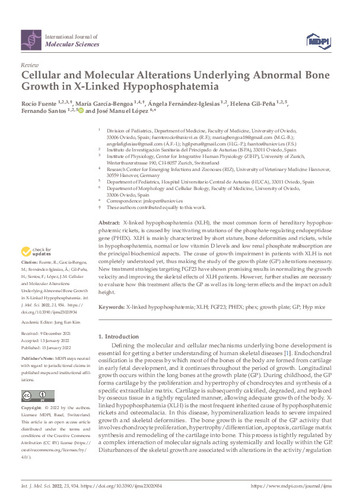Cellular and molecular alterations underlying abnormal bone growth in X-linked hypophosphatemia
Palabra(s) clave:
X-linked hypophosphatemia, XLH, FGF23, PHEX, phex, growth plate, GP, Hyp mice
Fecha de publicación:
Editorial:
Multidisciplinary Digital Publishing Institute (MDPI)
Versión del editor:
Citación:
Resumen:
Defining the molecular and cellular mechanisms underlying bone development is essential for getting a better understanding of human skeletal diseases [1]. Endochondral ossification is the process by which most of the bones of the body are formed from cartilage in early fetal development, and it continues throughout the period of growth. Longitudinal growth occurs within the long bones at the growth plate (GP). During childhood, the GP forms cartilage by the proliferation and hypertrophy of chondrocytes and synthesis of a specific extracellular matrix. Cartilage is subsequently calcified, degraded, and replaced by osseous tissue in a tightly regulated manner, allowing adequate growth of the body. X-linked hypophosphatemia (XLH) is the most frequent inherited cause of hypophosphatemic rickets and osteomalacia. In this disease, hypomineralization leads to severe impaired growth and skeletal deformities. The bone growth is the result of the GP activity that involves chondrocyte proliferation, hypertrophy/differentiation, apoptosis, cartilage matrix synthesis and remodeling of the cartilage into bone. This process is tightly regulated by a complex interaction of molecular signals acting systemically and locally within the GP. Disturbances of the skeletal growth are associated with alterations in the activity/regulation of the GP cartilage. Such disturbances are little known in XLH and will be the basis of the present review.
Defining the molecular and cellular mechanisms underlying bone development is essential for getting a better understanding of human skeletal diseases [1]. Endochondral ossification is the process by which most of the bones of the body are formed from cartilage in early fetal development, and it continues throughout the period of growth. Longitudinal growth occurs within the long bones at the growth plate (GP). During childhood, the GP forms cartilage by the proliferation and hypertrophy of chondrocytes and synthesis of a specific extracellular matrix. Cartilage is subsequently calcified, degraded, and replaced by osseous tissue in a tightly regulated manner, allowing adequate growth of the body. X-linked hypophosphatemia (XLH) is the most frequent inherited cause of hypophosphatemic rickets and osteomalacia. In this disease, hypomineralization leads to severe impaired growth and skeletal deformities. The bone growth is the result of the GP activity that involves chondrocyte proliferation, hypertrophy/differentiation, apoptosis, cartilage matrix synthesis and remodeling of the cartilage into bone. This process is tightly regulated by a complex interaction of molecular signals acting systemically and locally within the GP. Disturbances of the skeletal growth are associated with alterations in the activity/regulation of the GP cartilage. Such disturbances are little known in XLH and will be the basis of the present review.
DOI:
Patrocinado por:
Ministerio de Ciencia, Innovación y Universidades, Proyectos de Investigación en Salud Convocatoria 2018, Instituto de Salud Carlos III The European Commission for Marie Sklodowska-Curie Fellowships 2019 European Regional Development Funds 2013–2016 (ERDF, Grupin 14-020) Foundation of the University of Oviedo (FUO) Fundación para la Investigación y la Innovación Biosanitaria del Principado de Asturias (FINBA) Instituto de Investigación Sanitaria del Principado de Asturias (ISPA)
Colecciones
- Artículos [37541]
- Investigaciones y Documentos OpenAIRE [8416]
- Medicina [989]
Ficheros en el ítem





